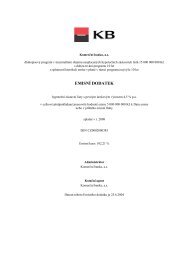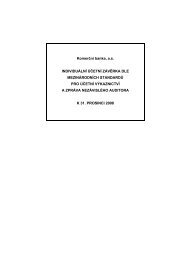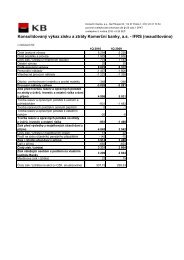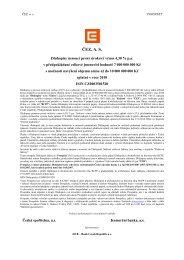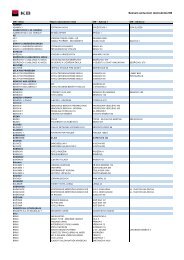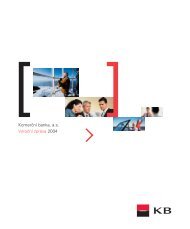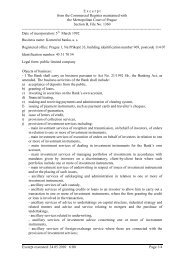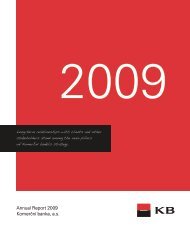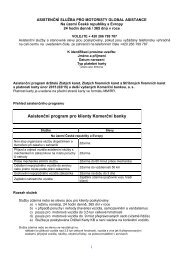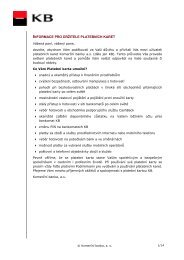KB prezent. angl - Komerční banka
KB prezent. angl - Komerční banka
KB prezent. angl - Komerční banka
You also want an ePaper? Increase the reach of your titles
YUMPU automatically turns print PDFs into web optimized ePapers that Google loves.
(e) Securities<br />
Securities held by the Bank are categorised into portfolios in accordance with the Bank’s intent on the acquisition of the securities<br />
and pursuant to the Bank’s security investment strategy. The Bank has classified securities as Trading securities, Available for sale<br />
and Held to maturity. With effect from 2002, the Bank has also carried securities in the category Acquired under initial offerings not<br />
designated for trading which are reported together with receivables. The principal difference among the portfolios relates to the<br />
measurement approach to securities and the recognition of their fair values in the financial statements.<br />
All securities held by the Bank are recognised using settlement date accounting and are measured at cost which, for coupon bonds,<br />
includes amortised cost, accrued coupon and an element of direct transaction costs associated to the acquisition of securities. All<br />
purchases and sales of securities that do not meet the “regular way” settlement criterion are treated as financial derivatives and are<br />
recognised on the face of the balance sheet upon settlement in fair value. The cost of debt securities is increased to reflect the<br />
accrued interest income using the effective interest rate method. Interest income includes the accrued coupon and the accrued<br />
difference between the nominal value of the security and its cost.<br />
Dividend income arising from securities is recorded as the dividends are declared and is included as a receivable in the balance sheet<br />
line Prepayments and accrued income and in Income from shares and equity investments in the profit and loss statement. Upon<br />
receipt of the dividend, the receivable is offset against the collected cash.<br />
Transactions with treasury shares (equity instrument) have a direct impact on the Bank’s equity.<br />
Trading securities<br />
Securities held for trading are financial assets (equity and debt securities, treasury bills, bills of exchange and participation<br />
certificates) acquired by the Bank for the purpose of generating a profit from short-term fluctuations in prices. Subsequent to the<br />
initial recognition, these securities are accounted for and stated at fair value which approximates the price quoted on recognised<br />
stock exchanges or any other public securities markets as appropriate.<br />
Unrealised gains and losses arising from the fair value remeasurement of securities as well as realised gains and losses are<br />
recognised as income in the profit and loss statement line Net profit or loss on financial operations.<br />
All purchases and sales of securities held for trading that require delivery within the time frame established by regulation or market<br />
convention (“regular way” purchases and sales) are recognised as spot transactions. Transactions that do not meet the “regular way”<br />
settlement criterion are treated as financial derivatives.<br />
Investments held to maturity<br />
Investments held to maturity are financial assets with fixed maturities that the Bank has the positive intent and ability to hold to<br />
maturity. The Bank carries debt securities in the held-to-maturity portfolio. Held to maturity investments are carried at amortised cost<br />
using the effective yield method.<br />
The Bank assesses on a regular basis whether there is any objective evidence that an investment held to maturity may be impaired.<br />
A financial asset is impaired if its carrying amount is greater than its estimated recoverable amount which is equal to the present<br />
value of the expected future cash flows discounted at the financial instrument’s original effective interest rate. The amount of the<br />
impairment loss for assets carried at amortised cost is calculated as the difference between the asset’s carrying amount and its<br />
recoverable amount. When an impairment of assets is identified, the Bank recognises provisions through the profit and loss<br />
statement line Net profit or loss on financial operations.<br />
Securities acquired under initial offerings not designated for trading<br />
Securities acquired under initial offerings not designated for trading are financial assets that have originated as a result of the<br />
provision of cash, goods or services directly to the borrower. Securities acquired under initial offerings are valued on the same basis<br />
as investments held to maturity. These securities are reported on the balance sheet together with amounts due from banks or<br />
customers, as appropriate.<br />
Securities available for sale<br />
Available for sale securities are those financial assets that are not classified as financial assets held for trading, held-to-maturity<br />
investments or securities acquired under initial offerings not designated for trading. This portfolio comprises equity securities and<br />
debt securities, including asset backed securities, and participation certificates. Securities available for sale are measured on the<br />
same basis as securities held for trading.



